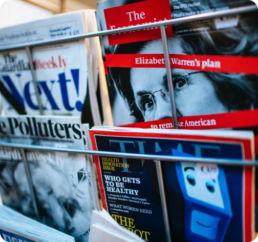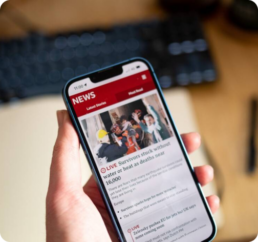Fake News 101
Why the spread of misinformation is a concern, and the steps we can take to be more conscious about what we consume


It’s Tuesday, August 25, 1835 and you’re reading the incredible findings of astronomer Sir John Herschel in the New York Sun. The series of six articles have announced the supposed discovery of life on the moon, made only possible by Herschel’s creation of a 24 foot telescope. The moon is depicted as having ‘beaches of white sands and a chain of slender pyramids’, populated by ‘a wealth of organisms, such as four-foot human-like creatures that could fly.’ In a time like this, on the cutting edge of scientific discovery… do you believe it?
This tale of discovery, later coined as the Great Moon Hoax, is just one example of the spread of misinformation in history. But why are we interested in fake news, and why should we care?
What is fake news?
“Fake News” is a collective of a few different related yet distinct terms:
Misinformation: information that is false, but the person who is disseminating it believes that it is true, for example the numerous false claims that drinking bleach could cure of prevent COVID-19.
Disinformation: information that is false, and the person who is disseminating it knows it is false. It is a deliverable, intentional lie, and points to people being actively misinformed by malicious actors. Think of the Russian operatives who used social media to spread false information to influence public opinion in the 2016 U.S. presidential election.
Malinformation: information that is based on reality but is used to inflict harm on a person, organisation or country. Both sides in the ongoing conflict in Syria, for example, have been accused of spreading malinformation to manipulate public opinion and justify military actions.
Why is fake news spreading faster than ever before?
As of 2021, there are now more than 4.26 billion social media users worldwide. Social media has revolutionised the way we consume and share knowledge by giving us access to information from people all over the world. People can now share information on social media, no matter what it is, and without editorial oversight. This has meant that information related to fake news is spreading faster than ever before… and on such a vast scale, it has proven to change attitudes, beliefs, perceptions, and even behaviour.
But why are we so inclined to believe fake news?
‘Confirmation Bias’: we’re psychologically inclined to seek out and believe information that reaffirms existing beliefs and values, and dismiss information that makes us question our preconceptions.
Emotional Appeal: fake news can play on emotions such as fear, anger or outrage, leaving us susceptible to believing and sharing news without proper due diligence.
Source Credibility: fake news can be created to intentionally appear trustworthy, making it increasingly difficult to discern what information is legitimate.
Lack of Media Literacy: we’re not necessarily taught the skills to evaluable the accuracy and credibility of information we read, leading us open to sharing misinformation.
Influence of Social Networks: social media algorithms are built to show us content that grabs our attention. We, as users, are then shown content that reaffirms our beliefs and aligns with our interests, meaning we’re not always exposed to different opinions.
Medical misinformation relating to the COVID-19 pandemic, influences on the outcome of government elections, and misinformation about ongoing wars are just a few examples of the real-life consequences this can have. With growing mistrust over the information we consume, promoting accurate information has the potential to transform the way we engage in online discussions.


But what makes information legitimate?
When it comes to seeking out legitimate sources, we should be looking for sources that promote accuracy, but there’s no doubt that sharing 100% accurate information is incredibly difficult. We should be wary that a lot of news sources may exercise some judgement or bias in the stories they report. However, that doesn’t mean we can come close to spreading accurate and legitimate information. When establishing the legitimacy of a source, look out for:
- Expertise: Was it written by someone who has knowledge in the subject matter?
- Accuracy & Citation: Does it offer references to other sources that verifies the information as factually correct?
- Objectivity: Does it present information without personal opinion?
- Currency: Is it the most up-to-date information on the subject?
- Relevance: Is it useful and relevant to the topic you’re researching?
- Reputation: Does the organisation or author behind the information have a history of producing trustworthy information?
If you can tick off all these criteria, you can be pretty sure that the information you’re reading is as legitimate as it can be. Use fact-checking websites or apps to verify the authenticity of information, and be cautious of sensational headlines. By learning to be more conscious about the information we consume, we can make more informed decisions when engaging in constructive discussions.
But it is also essential for social media platforms and news outlets to take responsibility for the spread of misinformation, and to make it easier for users to distinguish between fake and credible information. At ETHOS, we’re working hard behind the scenes to reduce the barriers users face when engaging in discourse online. Stay tuned for an exciting new feature we’re releasing this month that we hope can improve the way our users can engage in conversations on the platform. Together, we can work towards becoming a more informed society that is armed to progress change.
Sources: Smithsonian Magazine , Media Defence , Wall Street Journal , People’s Bank , Science Direct

